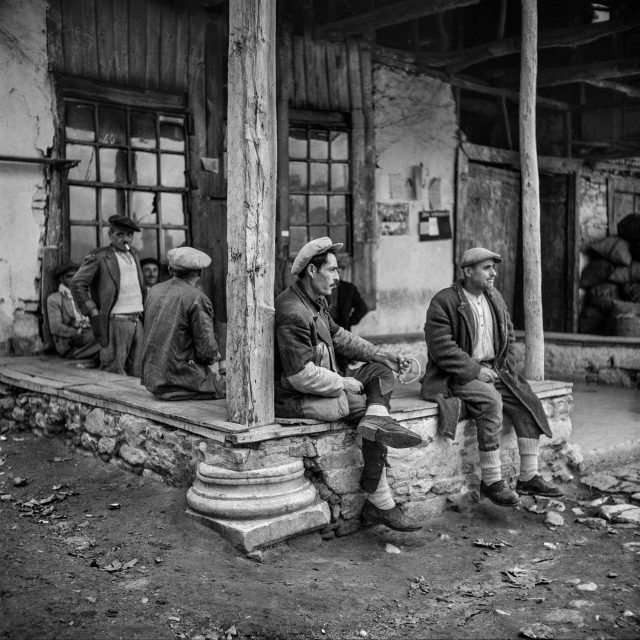The exhibition “In the Footsteps of Ara Güler: Exploring the Photographer’s Legacy,” which provides a broad perspective on the works of the world-renowned photographer and photojournalist Ara Güler, is set to welcome visitors on Aug. 9 through the collaboration of Qatar Museums (QM) and the Ara Güler Museum.
Opening at the Museum of Islamic Art (MIA) and continuing until Nov. 9, the exhibition highlights not only Güler’s mastery behind the lens but also his deep commitment to reflecting Türkiye’s cultural heritage. With a display featuring Güler’s classic Istanbul shots, archaeological photographs and portraits of significant figures worldwide, visitors will experience his profound impact on the art of photography and his efforts to preserve shared cultural memory.
Born in Istanbul in 1928, Güler is among the most significant names in photojournalism and photography, both nationally and internationally. The master photographer, who passed away in 2018, witnessed nearly the entire history of the Republic of Türkiye. With a career spanning 70 years, Güler’s works serve as a visual record of Türkiye and beyond.
The exhibition “In the Footsteps of Ara Güler: Exploring the Photographer’s Legacy” offers a comprehensive selection of the artist’s works, with photographs captured with a researcher’s eye that immortalize Istanbul’s historical monuments and everyday life. The exhibition includes 155 photographs, as well as correspondence, cameras and equipment, and a selection of ephemera from the Ara Güler Archive and Research Center collection.
The exhibition, which consists of four different sections, begins with visuals of Istanbul, with which Güler is closely associated, taking the viewer on a cultural and historical journey through Türkiye’s rich archaeological heritage sites and portraits of renowned figures of the 20th century. The exhibition concludes with a screening of Ara Güler’s experimental film, “Hero’s End.”
In the introductory section titled “Eternal Tapestry,” alongside photographs featuring Güler’s world-famous shots taken along routes he frequently walked in Istanbul, there are also early technique print paintings from the General Collection of Qatar Museums. Güler presents a portrait of a city in constant motion, with sounds and scents spilling beyond the frames against the backdrop of historical monuments and the architectural grandeur of the city. Bridging centuries and perspectives, this section brings together Güler’s intimate Istanbul photographs with the General Collection of Qatar Museums. The exhibition also includes 19th-century stereoscopes and albumen prints by pioneering photographers like the Gülmez Brothers, who transformed Istanbul’s charms and early visuals into keepsake books and postcards in Istanbul’s photo studios.
Romanticized landscapes of Istanbul are presented alongside Güler’s intimate photos, emphasizing the power of photography to be a cultural bridge across evolving city depictions. This section invites viewers to explore Istanbul, a timeless crossroads between East and West, through different times and lenses.
The second section, titled “Echoes from the Past,” emphasizes Ara Güler’s interest in history and documentation. Güler’s curiosity about archaeology led to his significant photo-reportages. Among these are the rediscovery of the ancient city of Aphrodisias, a UNESCO World Heritage Site, in the late 1950s and the photo-reportages of Mount Nemrut. In addition to these two photo-reportages, considered among Ara Güler’s most important works, photographs of historical sites and structures in Türkiye, from Neolithic findings to Ottoman artifacts, are exhibited. The visual narrative and poetic imagery in this section highlight the role of the art of photography in raising awareness about preserving the legacy of past times.

In the other section, portraits of world-renowned writers, artists, politicians, philosophers and other prominent contemporaries that Güler encountered throughout his life can be seen. Notable works in this section include the original handmade book, featuring portraits of seven significant figures, including Pablo Picasso, Tennessee Williams and Salvador Dali, and the portrait of artist Fahrelnissa Zeid, captured by Ara Güler, paired with paintings by Zeid borrowed specifically for this exhibition from the “Mathaf: Arab Museum of Modern Art” collection.
The exhibition concludes with the screening of “Hero’s End” (1973-1975), a film directed, scripted and produced by Ara Güler. The film, which tells the story of dismantling the battleship Yavuz that played a significant role in the Ottoman Empire’s entry into World War I, is a cinematic collage combining visual approaches from different sources, harmonized with an unusual soundtrack. This film includes compositions by renowned folk musician Ruhi Su, as well as historical photographs, sketches, and Güler’s own documentary recordings.





